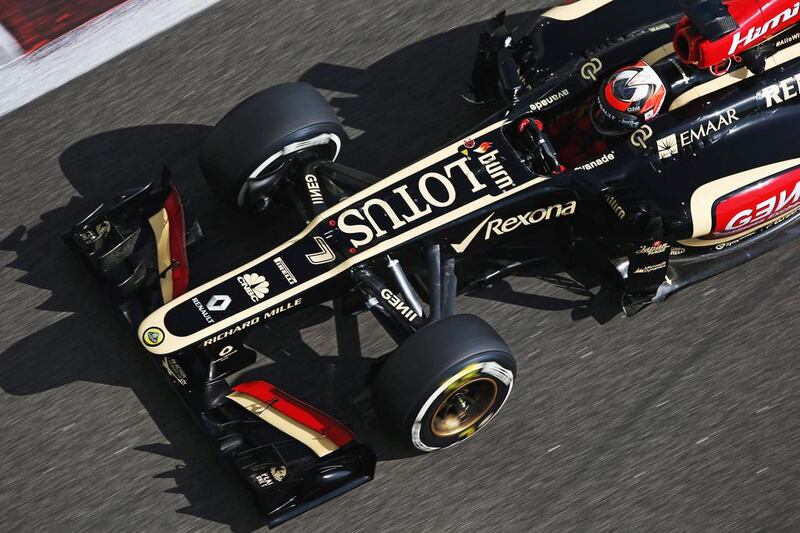The phrase "credit where it's due" has taken on a new meaning inside the Formula One paddock since Kimi Raikkonen's revelation on Friday that his Lotus team have yet to pay him a single euro of his €8 million (Dh39.6m) annual salary.
If the Finnish driver’s claims are correct – and nobody at Lotus has moved to deny them – then he deserves much credit for not revealing earlier the true extent of his employers’ financial issues.
Meanwhile, it appears that in Raikkonen’s mind at least, the marque based in the English village of Enstone have reached their credit limit as he is threatening to boycott the remaining two races of the year.
To understand how such a scenario could be allowed to develop at the elite level of motorsport requires not only a willingness to accept rumour, but also an understanding of the current financial landscape in the sport.
For instance, of the 11 racing teams in the F1 paddock, only four can be confidently labelled financially stable: Red Bull Racing and sister team Toro Rosso, and the automotive behemoths that are Mercedes and Ferrari.
McLaren-Mercedes, it is fair to say, are also likely secure despite the fact the team is about to lose its title sponsor and almost certain to finish the year without a podium for the first time since 1980.
Take a wander farther down the paddock, however, and the overriding feeling is that of financial fear.
Almost 50 per cent of the drivers who will line the 22-car grid at today’s Etihad Airways Abu Dhabi Grand Prix have this season paid for the privilege. Five of these pay-drivers started the season with no experience of racing at the top level.
Yet recent years have shown pay-drivers to be one of the most lucrative vehicles for bringing in money.
Pastor Maldonado, the Venezuelan driver at Williams, is believed to provide in excess of £20 million (Dh117m) per year, while Carlos Slim Domit, the son of Carlos Slim Helu, the man Forbes magazine consider to be the world’s richest man, has proved influential in the careers of Mexican duo Sergio Perez and Esteban Gutierrez.
Lotus’ decision in 2012 to tempt Raikkonen, the 2007 world champion, back from a two-year F1 hiatus – initially at least – appeared to pay for itself. The marque went from mid-table mediocrity to the popular home of one of the sport’s most engrossing characters.
The focus on the team brought in new marketing opportunities and, in Raikkonen, they had a driver capable of fighting for race wins.
Raikkonen’s remarkable victory at Yas Marina Circuit last November was Lotus’ first win since 1987 and he followed it up with a season-opening triumph in Melbourne four months later.
Now we know that even in celebration, no salary was forthcoming. Essentially, Raikkonen has this year been racing – and, naturally, risking his life – for free.
With a car capable of winning races, it is no surprise the Finn did not grumble. A second world championship title is arguably of far more value to an F1 driver than a few extra zeroes on their bank balance.
It is only in recent months, as his car’s performance slowly dropped off, that his willingness to work gratis started to wilt.
In September, when Raikkonen confirmed he will join Ferrari in 2014, he said one of the primary reasons was because Lotus had failed to pay him.
The straw that broke the camel’s back did not arrive in the Abu Dhabi desert, but rather at India’s Buddh International Circuit last Sunday.
And it likely had a lot less to do with the explicit exchange between Raikkonen and Alan Permane, Lotus’ trackside operations director, than has been cited.
Teams are renowned for using profanity on team radio in an attempt to prevent television broadcasters from transmitting private communications.
The colourful language used in the altercation was likely less of an issue than what Permane was ordering Raikkonen to actually do: move aside and let Romain Grosjean, his podium-bound teammate, past.
Grosjean has now beaten the 34 year-old Finn at three of the past five races. The two have no personal relationship, despite having shared an employer for two years.
When Grosjean was asked recently by a reporter for his thoughts on his notoriously reticent stablemate, he replied: “Basically I don’t know him. He is with me as he is with you.”
Add to that the fact Raikkonen is not being paid for his troubles and the irritation he feels is increasingly easy to understand. Lotus argue it was a similar situation last year and that their driver got all the money he was due at the end of the season.
This year, they continue to await the confirmation of fresh investment before paying out or planning for next year.
Lotus announced in June that a consortium of private investors, including an American hedge fund manager and an Abu Dhabi-based multinational business group, had acquired a 35 per cent stake. The team later acknowledged the deal had yet to be finalised. It remains unconfirmed.
Until the sponsor money arrives, Raikkonen is unlikely to receive his salary. He has threatened to refuse to race at the two remaining grands prix, in the United States and Brazil, yet if one thing is known of Raikkonen, it is that he lives for racing.
Ending his season two contests early would deprive him of the one element of the sport he actually enjoys.
How the next few weeks unravel will prove as fascinating as Raikkonen himself, yet as he said last year on route to victory at Yas Marina, he knows what he is doing. For now, at least, he is the only one who does.
gmeenaghan@thenational.ae
Follow us on twitter at @SprtNationalUAE





